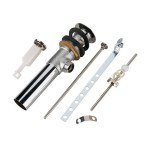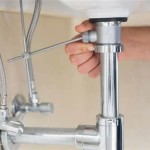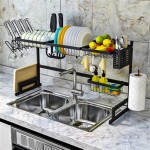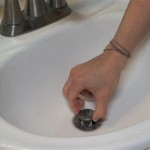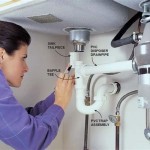Home Remedies for a Clogged Kitchen Sink
A clogged kitchen sink is a common household plumbing issue that can disrupt daily routines and cause significant inconvenience. Standing water, slow drainage, and unpleasant odors are all telltale signs of a blockage. While professional plumbing services offer a solution, many clogs can be effectively addressed using readily available household items and simple techniques. This article explores various home remedies for unclogging a kitchen sink, providing a comprehensive guide to tackling this problem without resorting to harsh chemicals or expensive professional assistance.
Understanding the Common Causes of Kitchen Sink Clogs
Identifying the root cause of a clog is crucial for selecting the most effective remedy. Kitchen sink clogs typically arise from a combination of factors, primarily related to the types of materials that frequently enter the drain. Grease, food scraps, hair, soap scum, and mineral buildup are the most common culprits. Grease, in particular, solidifies as it cools, adhering to the pipe walls and trapping other debris. Food particles, especially starchy substances like rice and pasta, can swell and create significant obstructions. Hair and soap scum bind together, forming stubborn masses that impede water flow. Over time, mineral deposits from hard water can also accumulate, narrowing the drainpipe and contributing to clogs.
The configuration of the sink's plumbing system also plays a role. The P-trap, a curved section of pipe located under the sink, is designed to trap debris and prevent sewer gases from entering the home. While it serves a vital function, the P-trap can also become a collection point for clogs. The drainpipes themselves, particularly if they are older or have sections with reduced diameter, are more susceptible to blockages. Improperly installed plumbing or pipes with insufficient slope can also contribute to drainage problems.
Incorrect disposal practices exacerbate the issue. Pouring grease down the drain is a leading cause of clogs. Similarly, grinding coffee grounds or vegetable peels in the garbage disposal can overload the system and lead to blockages further down the drain line. Regular preventative maintenance, such as flushing the drain with hot water and using drain strainers, can significantly reduce the likelihood of clogs forming.
Effective Home Remedies for Unclogging a Kitchen Sink
Several home remedies offer viable solutions for unclogging a kitchen sink, ranging from simple mechanical methods to chemical reactions involving common household ingredients. The choice of remedy depends on the severity of the clog and the materials involved.
Boiling Water
The simplest and often most effective first step in unclogging a sink is to pour boiling water down the drain. Heat the water in a kettle or pot until it reaches a rolling boil. Carefully pour the entire volume of boiling water directly into the drain opening. The hot water can melt grease and dissolve some food particles, effectively dislodging the clog. This method is particularly effective for recent clogs caused by grease accumulation.
It's important to exercise caution when using boiling water, especially with PVC pipes, as excessively hot water can potentially soften or damage them. If the sink is connected to PVC pipes, let the boiling water cool slightly for a few minutes before pouring it down the drain. Also, avoid pouring boiling water down the drain if chemical drain cleaners have recently been used, as the combination can create dangerous fumes.
Baking Soda and Vinegar
A mixture of baking soda and vinegar creates a chemical reaction that can help break down clogs. Pour approximately one cup of baking soda down the drain, followed by one cup of white vinegar. The combination will produce a fizzing action as the baking soda reacts with the vinegar, releasing carbon dioxide gas. This fizzing action helps to loosen and dislodge the clog.
Allow the mixture to sit in the drain for at least 30 minutes, or preferably overnight, to maximize its effectiveness. After the waiting period, flush the drain with hot water. The hot water will help to wash away the loosened debris. If the clog persists, repeat the process. This method is generally safe for all types of pipes and is a more environmentally friendly alternative to harsh chemical drain cleaners.
Plunger
A plunger is a manual tool that uses suction and pressure to dislodge clogs. Ensure there is enough water in the sink to cover the cup of the plunger. Position the plunger directly over the drain opening, creating a tight seal. Push and pull the plunger up and down vigorously for several minutes. The repetitive motion creates pressure that can break up the clog and force it down the drain.
For the plunger to work effectively, it is crucial to maintain a tight seal around the drain opening. If the sink has an overflow drain, seal it off with a wet cloth or duct tape to prevent air from escaping. After plunging, remove the plunger and check if the water drains. If the clog persists, repeat the plunging process several times. Different types of plungers are available, including cup plungers (best for flat surfaces) and flange plungers (designed for toilets but adaptable for sinks). A flange plunger may provide a better seal for some sink drain designs.
Wire Hanger or Drain Snake
A straightened wire coat hanger or a drain snake (also known as an auger) can be used to manually break up and remove clogs. Straighten a wire coat hanger, leaving a small hook at the end. Carefully insert the wire into the drain opening, and use the hook to probe for the clog. Try to break up the clog or pull it out of the drain. Avoid pushing the clog further down the drainpipe.
A drain snake is a more specialized tool that consists of a flexible metal cable with a corkscrew-like tip. Insert the drain snake into the drain opening, and rotate it as you feed it down the drainpipe. When you encounter resistance, continue rotating the snake to break up the clog or hook onto it. Carefully pull the snake back out of the drain, removing any debris attached to it. Repeat the process until the drain is clear.
Use caution when using a wire hanger or drain snake to avoid scratching or damaging the inside of the drainpipe. Wear gloves to protect your hands from bacteria and debris. After using either tool, flush the drain with hot water to remove any remaining loose particles.
Wet/Dry Vacuum
A wet/dry vacuum can be used to suck out clogs from the drain. Remove any standing water from the sink. Set the vacuum to its wet setting. Position the vacuum hose directly over the drain opening, creating a tight seal. Turn on the vacuum and allow it to run for several minutes. The suction from the vacuum can pull the clog up and out of the drain.
Ensure the vacuum hose is securely sealed around the drain opening to maximize suction. If the vacuum is not effective, try using a plunger in conjunction with the vacuum. After using the vacuum, flush the drain with hot water to remove any remaining loose particles.
Preventative Measures to Avoid Future Clogs
Preventing clogs is often easier and more cost-effective than dealing with them after they occur. Implementing a few simple preventative measures can drastically reduce the likelihood of kitchen sink clogs.
Always use a drain strainer. A drain strainer is a mesh basket that fits into the drain opening and catches food scraps, hair, and other debris before they enter the drainpipe. Empty the drain strainer regularly to prevent it from overflowing and becoming a source of clogs. Different types of drain strainers are available, including stainless steel, plastic, and silicone options. Choose a strainer that fits your sink drain and is easy to clean.
Avoid pouring grease down the drain. Dispose of grease in a separate container, such as an empty jar or can. Allow the grease to cool and solidify, then discard it in the trash. Alternatively, many communities offer grease recycling programs. Avoid pouring hot grease into the sink, even if you intend to flush it with hot water. The grease will solidify as it cools and adhere to the pipe walls.
Flush the drain with hot water regularly. Once a week, pour a pot of boiling water down the drain to help dissolve any grease or food particles that may be accumulating. Run hot water down the drain for several minutes after each use to wash away loose debris. This simple practice can prevent clogs from forming.
Avoid grinding certain foods in the garbage disposal. While garbage disposals are convenient for disposing of food waste, certain foods can cause problems. Avoid grinding coffee grounds, eggshells, banana peels, potato peels, and other fibrous or starchy foods. These foods can clump together and clog the drainpipe. Cut large food scraps into smaller pieces before grinding them in the garbage disposal. Run cold water while the garbage disposal is operating to help flush the debris down the drain.
Consider using enzyme-based drain cleaners. Enzyme-based drain cleaners contain natural enzymes that break down organic matter, such as grease, food scraps, and hair. These cleaners are gentler on pipes than chemical drain cleaners and are less likely to cause damage. Follow the instructions on the product label carefully. Use enzyme-based drain cleaners as a preventative measure, rather than as a solution for existing clogs. Follow the instructions and never mix with other drain cleaners. Avoid chemical ones whenever possible.
By understanding the causes of kitchen sink clogs and implementing these preventative measures, homeowners can significantly reduce the frequency of plumbing problems and maintain a smoothly functioning kitchen.

How To Unclog A Kitchen Sink Drain

How To Unclog A Kitchen Sink Using Baking Soda And Vinegar

How To Clean Drains With Baking Soda And Vinegar Liquid Plumr

How To Clean And Unclog A Kitchen Sink Drain Diy Family Handyman

How To Unclog A Sink 5 Natural Easy Ways Kitchen Cabinet Kings

How To Clear A Clogged Sink Drain With Vinegar Baking Soda

How To Unclog A Kitchen Sink Drain

Home Remedies For A Clogged Drain Superior Plumbing Drains

6 Ways To Unclog A Sink Drain Anderson Lumber

How To Unclog A Kitchen Sink Drain
